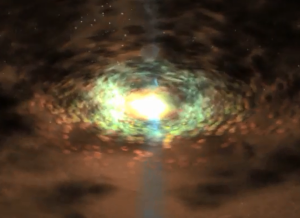Clouds darken the centre of galaxies
Heavy cloud, overcast in some places and strong gusts are to be expected. If there was a weather forecast for distant galaxies, it would sound quite similar – especially for the centre of the galaxies where black holes consume all surrounding matter with an insatiable hunger. An international team of researchers led by Dr. Alex Markowitz from FAU have discovered that gigantic clouds made up of hot gas circulate around the black holes and darken their surroundings like an approaching storm blocking the sun on a summer’s day.
The gases weigh twice as much as the earth and reach a magnitude which is almost beyond comprehension. If such a cloud existed in our solar system, it would reach from the sun to pluto. These clouds are created when black holes – which can be millions or even billions times more dense than our sun – consume matter from across the universe. As the matter is consumed, a ring of hot gas forms which compresses and becomes so hot that it releases X-rays.

Researchers previously believed that the gas rings surrounding the black holes had a homogeneous structure like giant doughnuts. Researchers were able to track the clouds with the American Rossi X-ray Timing Explorer (RXTE) satellite. The Rossi X-Ray Timing Explorer has spent sixteen years gazing into the depths of space and observing the same objects on a regular basis. Through analysing time-lapse images gathered by the satellite, researchers have been able to pinpoint the cloud structures. Some of the clouds only darken their surroundings for a matter of hours, others plunge their galaxies into darkness for several years.
The new findings will help the researchers to answer unsolved questions in astronomy including how gas from thousands of light years away ends up in these rings. ‘Research into the size, structure and number of the gas clouds will help us to understand the transport mechanism better,’ says Dr. Alex Markowitz. Markowitz is an astronomer at the University of California, San Diego (UCSD) and is currently researching at the FAU Erlangen Centre for Astroparticle Physics as part of a Humboldt scholarship. His research involves international collaboration including co-operation with Dr. Mirko Krumpe at the European Southern Observatory in Garching, Germany, and Dr Robert Nikutta from Universidad Andrés Bello in Chile.
Their research results have been published in the journal ‘Monthly Notices of the Royal Astronomical Society’.
This NASA animation on YouTube shows a black hole surrounded by gas clouds.
Further information:
Erlangen Centre for Astroparticle Physics/Dr. Remeis-Sternwarte
Dr. Alex Markowitz
Phone: +49 951 95222 26
alex.markowitz@sternwarte.uni-erlangen.de
Prof. Dr. Jörn Wilms
Phone: +49 951 95222 13
joern.wilms@sternwarte.uni-erlangen.de
